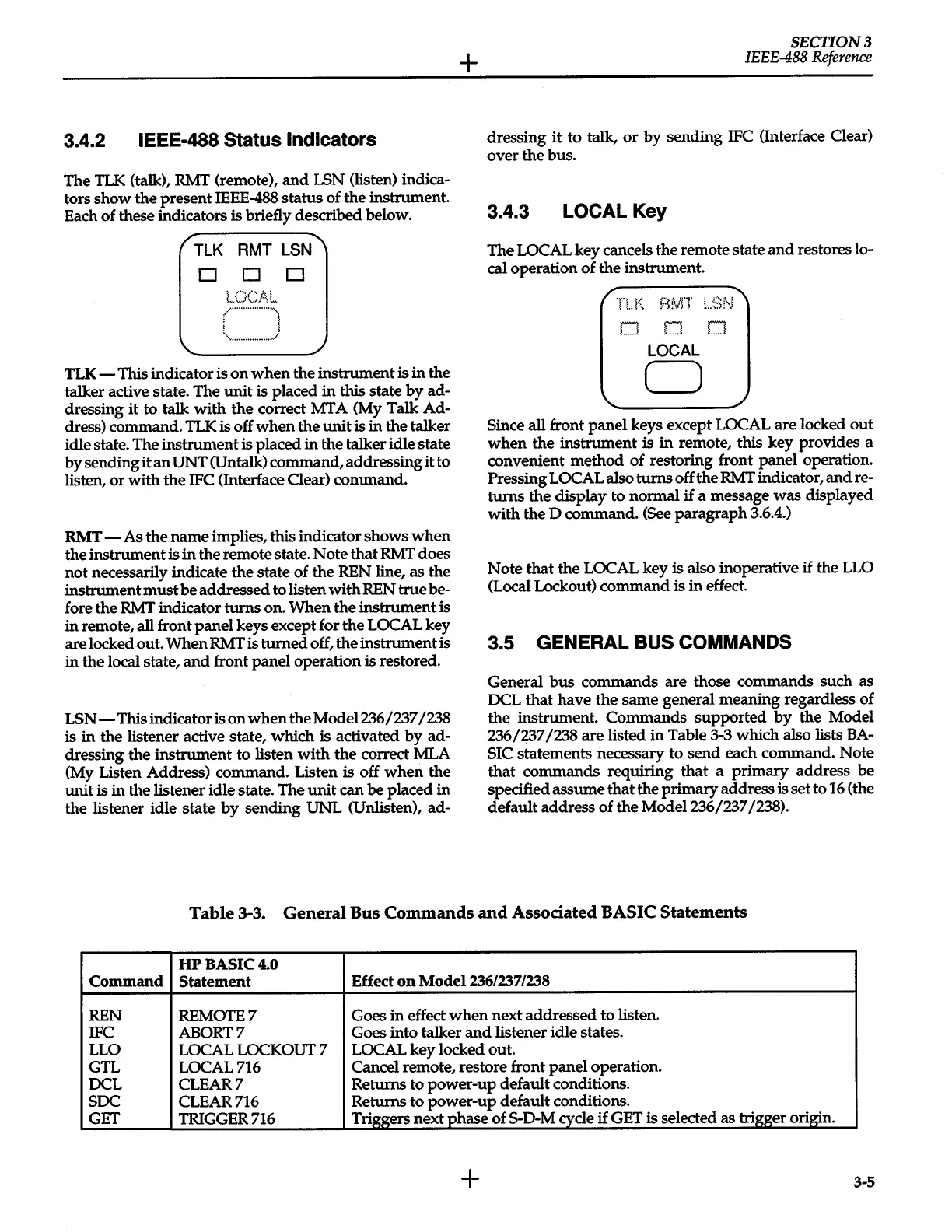3.4.2
IEEE-488 Status Indicators
The TLK (talk), RMT (remote),
and
LSN
(listen) indica-
tors
show
the
present IEEE-488 status
of
the instrument.
Each
of
these indicators is briefly described below.
TLK
RMT
LSN
D D D
LlJC/\L
(
.................
'\
(
...............
)
TLK-
This indicator is
on
when
the instrument is
in
the
talker active state. The
unit
is placed
in
this state
by
ad-
dressing
it
to talk
with
the
correct MTA (My Talk Ad-
dress) command. TLK is off
when
the
unit
is
in
the talker
idle state. The instrument is placed
in
the talker idle state
by
sending
it
an
UNT
(Untalk) command, addressing
it
to
listen,
or
with
the
IFC (Interface Clear) command.
RMT-
As
the
name
implies, this indicator shows
when
the instrument is
in
the remote state.
Note
that
RMT does
not
necessarily indicate
the
state
of
the REN line, as
the
instrument
must
be
addressed to listen
with
REN
true
be-
fore the RMT indicator
turns
on.
When
the
instrument
is
in
remote,
all
front
panel
keys except for
the
LOCAL
key
are locked out.
When
RMT is
turned
off,
the
instrument
is
in
the local state,
and
front panel operation is restored.
LSN-
This indicator is
on
when
the
Model236
/237/238
is
in
the listener active state, which
is
activated
by
ad-
dressing the instrument to listen
with
the
correct MLA
(My Listen Address) command. Listen is off
when
the
unit
is
in
the listener idle state. The
unit
can
be
placed
in
the listener idle state
by
sending UNL (Unlisten),
ad-
+
SECTION3
IEEE-488
Reference
dressing
it
to talk,
or
by
sending IFC (Interface Clear)
over
the
bus.
3.4.3
LOCAL Key
The
LOCAL
key cancels
the
remote state
and
restores lo-
cal operation
of
the
instrument.
TLK
R!vH
LSN
D 0 D
LOCAL
D
Since
all
front
panel
keys except
LOCAL
are locked
out
when
the
instrument is
in
remote, this key provides a
convenient
method
of
restoring front
panel
operation.
Pressing
LOCAL
also
turns off
the
RMT indicator,
andre-
turns
the
display to normal
if
a message
was
displayed
with
the D command. (See
paragraph
3.6.4.)
Note
that
the
LOCAL key is also inoperative
if
the LLO
(Local Lockout)
command
is
in
effect.
3.5 GENERAL
BUS COMMANDS
General
bus
commands are those commands such as
DCL
that
have
the
same
general meaning regardless of
the
instrument.
Commands
supported
by
the Model
236/237/238 are listed
in
Table 3-3 which also lists
BA-
SIC statements necessary to
send
each command. Note
that
commands
requiring
that
a
primary
address
be
specified assume
that
the
primary
address is
set
to 16 (the
default
address
of
the
Model236/237
/238).
Table
3-3.
General
Bus
Commands
and
Associated
BASIC
Statements
HPBASIC4.0
Command
Statement
Effect
on
Model236/237/238
REN
REMOTE7
Goes
in
effect
when
next addressed to listen.
IFC
ABORT7 Goes into talker
and
listener idle states.
LLO
LOCAL LOCKOUT
7
LOCAL
key locked out.
GTL
LOCAL716
Cancel remote, restore front
panel
operation.
DCL
CLEAR7 Returns to
power-up
default conditions.
soc
CLEAR716 Returns to
power-up
default conditions.
GET
TRIGGER716
Triggers next
phase
of
S-0-M
cycle
if
GET is selected as trigger origin.
+
3-5

